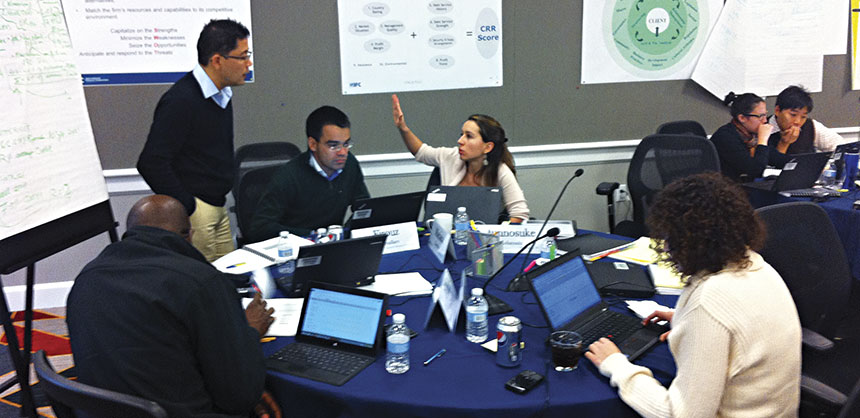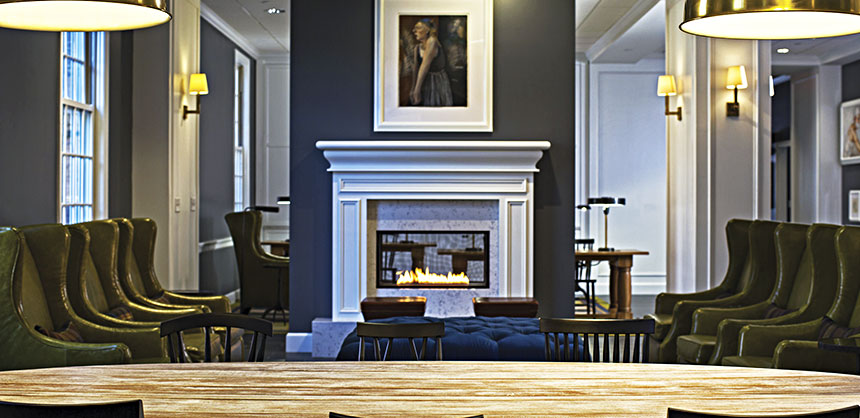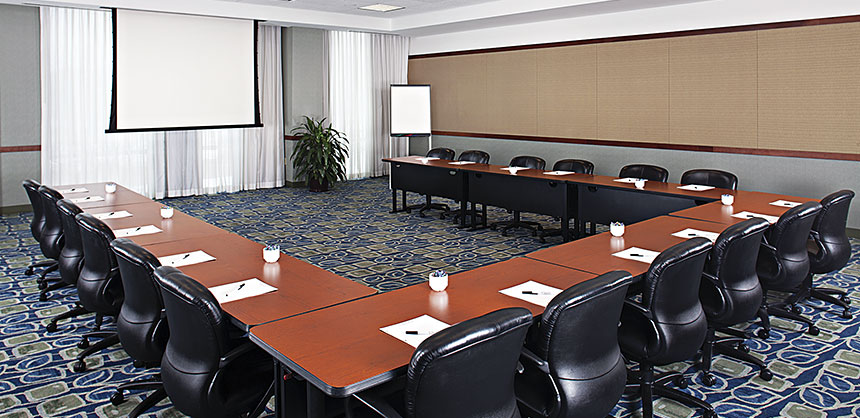- Insurance & Financial Meetings Management/
- Conference Centers Uncovered
Conference Centers UncoveredJanuary 1, 2014
A Best-Kept Secret No More By John Buchanan
In addition to the IACC-approved 40,000-sf conference center with 38 meeting rooms, the 316-room Cheyenne Mountain Resort, Colorado Springs, CO, boasts 18 holes of championship golf, swimming pools, tennis courts and a 35-acre lake. Credit: Cheyenne Mountain Resort
Not many meeting industry suppliers would cite the long recession as having benefited their business. But one entire category can — and that is conference centers.
And that doesn’t mean traditional hotels that have added “conference center” to their name as a way of attracting more meeting clients. It means dedicated conference center facilities certified by the International Association of Conference Centres (IACC). There are just 350 member facilities in the Americas, Australia/Asia-Pacific, and Europe combined.
During the recession, more and more meeting planners sought out bona fide conference centers as venues because by definition, a significant majority of their total business comes from meetings — and they offer an all-inclusive pricing model and lower costs that help companies adhere to tight budgets.
Now that the economy has recovered, however, the appeal of conference centers is more universal than ever before, says Mark Cooper, CEO of the Chicago-based IACC.
“With a conference center, you’re walking into a specialized facility that has a team of people who are completely focused on meetings and conferences.”
— Mark Cooper, CEO, International Association of Conference Centres (IACC), Chicago, IL
“Coming out of the economic downturn, we’ve seen companies investing more in people and investing more in training,” Cooper says. “And conference centers are the perfect facilities for those kinds of meetings.”
In fact, he adds, many of the biggest users of conference centers are now Fortune 500 companies that have seen the light.
The distinction between a hotel that simply calls itself a conference center and a facility that meets IACC’s certification standards is important.
IACC properties must generate at least 60 percent of their total revenue from meetings, and a minimum of 60 percent of its meeting space must be dedicated, single-purpose space used only for conferences. Very few traditional hotels meet those requirements, including even the most successful major-flag hotels in A-list meeting destinations.
In addition, IACC facilities must offer a package plan rate that includes guest rooms, meeting space, three meals a day, continuous refreshment breaks throughout the day and conference-related technology such as AV.
Because that specific model has proven so popular with planners in recent years, both Marriott and Hilton have developed IACC-approved properties. “They recognize that hotels are not the same as conference centers, so that for those specialized facilities they take IACC certification to reinforce the branding of those properties as legitimate conference centers,” Cooper says, noting what he says is the most critical point.
“The single biggest issue for any conference center — the one that I think is more important than any of the others — is the expertise and the skill sets of the people who are supporting your meeting. Conference centers are specialists. And the example I always use in terms of comparing them to hotels is that of someone who wants to go buy a laptop computer. Are you going to walk into a Walmart, or are you going to buy from Hewlett-Packard or Apple? Most people today would want to buy from a specialized seller whose entire business is built around a core product. And that scenario is no different when you compare a conference center to a hotel. With a conference center, you’re walking into a specialized facility that has a team of people who are completely focused on meetings and conferences.”
Susan Murphy, senior program manager at Washington, DC-based International Finance Corpora-tion (IFC), an affiliate of The World Bank, is a loyal, longtime user of conference centers who corroborates Cooper’s assertion. Simply because of a conference center’s different business model, she believes they are better by definition at hosting meetings and conferences than a traditional hotel.
“The staff at a conference center just typically better understands your needs and the goal of your meeting,” Murphy says. “They just get it. And that means that you and your attendees have a superior experience.”
The expectation of such an experience from planners is no accident, Cooper says. “At a conference center, you have people that are absolutely passionate about your meeting and who are determined to do everything in their power to make it a success,” he says. “And that is also true because at a conference center, the team understands that their own success is strictly based on putting on exceptional meetings time after time. That’s also because unlike hotels, which generally get a lot of different meeting clients over the course of the year, a conference center relies on clients that keep coming back time after time for years and years because of the experiences they’ve had.”
And that describes Murphy to a tee, she says.
“We often use a conference center, because that means everything is in place from day one and we don’t have to worry about all those details, such as menus or the setup of meeting space. And AV planning is included, and that something that can get very complicated.”
— Joan Orentlicher, CMP, assistant vice president, meetings, conferences and travel, LOMA & LIMRA, Atlanta, GA
Dedicated Meeting Space
One of the things Murphy likes best about genuine conference centers is their truly dedicated meeting space.
“The fact that a conference center has dedicated meeting space, as opposed to using the same space for different functions during the same day or that night if you’re not actually holding a session, is a big, big factor for me,” she says. “In a hotel, they want to also book that space for other things on the same day or night if you’re not using it. And you’re never told in advance that another event is going to also be held in your meeting room. So as you proceed, the sales manager will come up and say, ‘Oh, you know, we have a dinner booked in your meeting room for tonight, so you need to clear out.’ And that means you have to pack up all of your materials and move out so someone else can have a dinner or event in the same space. When I experienced that for the first time after moving a meeting into a hotel after making a lot of use of conference centers, I was flabbergasted. I said, ‘Look, I booked this room for a week.’ And they said, ‘No, actually you have to put a 24-hour hold on it if you want exclusive use of it.’ And let me tell you, that is a problem for me in terms of how hotels do business. If you’re holding a real meeting, a real training session, there are a lot of materials and miscellaneous items in your meeting rooms and you don’t want to have to tell people we need to clear out of there because there’s another event in here tonight.”
And the more intensive the meeting, Murphy says, the more important that distinction is.
By comparison, IACC certification requires that multi-day meeting clients “can safely store materials and equipment overnight in dedicated conference rooms.”
But there are other “environmental” factors that are just as important, says Murphy, who is a longtime and frequent user of the 111-room College Park Marriott Hotel and Conference Center located at the University of Maryland. The state-of-the-art facility recently completed a comprehensive one-year renovation.
“We like that particular facility so much because for one thing, it’s located on a major college campus,” Murphy says. “It’s located at a major center of learning. So when you’re bringing people in for meeting, it’s a very serious meeting, because you’re on a college campus. And I just like the feel of that.”
Another advantage, she says, is tight security. She often brings in international attendees for her meetings and a safe, secure campus is another perceived benefit of the UM facility.
In addition to that are unique perks, such as attendee use of the state-of-the-art gym facilities. “A lot of our attendees are young and they’re into fitness,” Murphy says. “So Marriott bought passes for our people to use at the UM athletic complex, which is just unbelievable. It’s the same facility Michael Phelps used to train for the Olympics. Our attendees, who come from all over the world, are just amazed by it.”
UM also has world-class performing arts facilities, which means easily available entertainment on the weekends.
The Pricing Model
Another key distinction for Murphy is a conference center’s pricing model and billing practices. There is no doubt in her mind, she says, that the all-inclusive pricing of a conference center generates significant bottom-line savings over the cost of a hotel.
But differences in billing are equally as important to her, she says.
“Hotels usually want to separate food and beverage from accommodations,” Murphy says. “And that means I am totally bombarded with a lot of separate invoices and constantly being asked to verify all of the charges, particularly for meals. By comparison, when you go to a conference center, everything is built into the price you pay, so you don’t have to worry about any of that.”
Because she sometimes uses hotels for meetings, Murphy says, she has talked to hotel salespeople about her issue with their billing. “I have said to hotels, ‘Just go ahead and put everything on one bill, because that makes things a lot easier for me,’ ” she says. “But then they say, ‘Well, we need that (broken down) information for our purposes, because we track everything by the profits we make.’ ”
Part of the reason for that is the ever more powerful role of hotel revenue managers, whose primary responsibility is to analyze and maximize the bottom-line profits to be generated from every aspect of a meeting.
Joan Orentlicher, CMP, assistant vice president, meetings, conferences and travel, at Atlanta-based LOMA & LIMRA, which represents the interests of insurance companies and offers research and educational services to financial companies, is another frequent user of a particular conference center — the Atlanta Marriott Buckhead Hotel & Conference Center, which added the only IACC-certified conference center in Buckhead and features 25,000 sf of IACC-certified conference space.
Like Murphy, Orentlicher says that the primary benefit she sees is knowing the exact total cost of a meeting, per attendee, in advance. That’s important to Orentlicher because her attendees typically pay their own way to the meeting and are looking for a fixed cost that also delivers good value.
“And for me, as the planner, that means that because everything we want is streamlined into a single price, that is just very convenient,” says Orentlicher, adding that she also finds the contracting process simpler and easier with a conference center.
Tech Savvy
In addition to pricing and overall service benefits, Cooper says, conference centers also provide superior technology support — again because meetings are their core business.
Because hotels now typically farm out technology services such as AV to third-party vendors — and also mark them up significantly — conference centers are designed to do a better job, often at a lower cost.
“And our members not only deliver leading edge technology, but they include that in a complete meeting package, which means that everything that is necessary for a productive meeting is included in a single price,” Cooper says. “Planners know exactly what they’re paying. And unlike with a hotel, they’re also not paying anything for basic adjustments to what they require if their needs change a bit.”
Murphy agrees that the tech-savvy staff members at the College Park Marriott Hotel and Conference Center are among the reasons she keeps going back. “And for me, it’s really about the support more than the actual technology,” she says. “And part of that is, because AV and related technology is so expensive now, both at hotels and conference centers, we will often bring our own equipment. And we get beautiful support from conference centers. Everybody knows what they’re doing and what we want. But when you go to a hotel you don’t always get that level of support.”
In addition, because conference centers have the equipment and staff in-house, it is billed out at a fixed cost, rather than being marked up, which means cost savings. “These days, when we do use a hotel, we find that they farm out their AV,” Murphy says. “And boy is it pricey. So that is just another big, big difference between conference centers and hotels.”
Although Orentlicher concurs with Murphy’s assessment of the basic benefits of a conference center, she adds one more that is of particular importance to her — planner peace of mind.
“We do about 200 meetings a year and we have eight staff members to manage those meetings,” she says. “And of those 200, about 60 are the kinds of small meetings we do, the ones we often hold at conference centers. Small meetings can be as labor-intensive as a large meeting. So to reduce the demand on our internal resources to do these small meetings, we often use a conference center, because that means everything is in place from day one and we don’t have to worry about all those details, such as menus or the setup of meeting space. And AV planning is included, and that something that can get very complicated.”
So, she says, in the end, the biggest benefit of a conference center is simply a streamlined and more efficient, worry-free planning process.
The Future Is Here
Precisely because conference centers got a boost for their business model during and since the recession, there has been some new construction, as well as recently completed renovations at some major facilities.
Last year, Dolce Hotels & Resorts added a new property to its highly-respected conference center portfolio, the 146-room The Alexander in downtown Indianapolis. The property — the first LEED-certified and IACC-sanctioned hotel in Indiana — also features 10 junior suites, 36 one-bedroom residential studios, 16 two-bedroom residential suites and a presidential suite.
Meanwhile, Benchmark Hospitality International — another leading operator of major conference centers — completed renovations at a trio of its properties: the 316-room, extremely popular Cheyenne Mountain Resort in Colorado Springs; the 199-room The Chattanoogan Hotel in Chattanooga, TN, the only AAA Four Diamond property and IACC-certified property in town; and the 294-room Eaglewood Resort & Spa in Chicago.
As physical improvement of IACC facilities continues in 2014, the industry is also now aiming for even more innovation designed to generate even more interest and loyalty from meeting planners, Cooper says.
“For example, one of the biggest trends we’re seeing is demand for more innovation in terms of setting up rooms and creating environments,” he says. “By that I mean new ideas in terms of how the rooms are set up or the style of the meeting. That means planners want more flexibility now in terms of how the experience is created for attendees.”
And, Cooper says, that in turn goes to the larger trend of so-called meeting architecture and new research into brain science and learning. As a result, he says, no longer is there a narrowly defined sense of how to set up meeting rooms or execute sessions.
“Nobody wants their meeting to be exactly like the last one anymore,” Cooper says. “They want something different. They want something new. And our members are always willing to work with a planner to develop and deliver that. They don’t just say, ‘Well, here are our four- or five-room configurations. Pick one.’ ”
A debate has also begun recently about the time-tested and fairly standard conference center pricing model.
A new survey released in Decem-ber by PHG Research, a division of Pompan Hospitality Global, reported that many conference center managers now perceive a need to adjust meeting packages to better reflect evolving customer preferences.
For example, facility managers cited growing interest from meeting clients in a modified meeting package (MMP) that would provide more flexibility than the longstanding complete meeting package (CMP) currently in widespread practice.
One reason: Almost half of responding properties in the PHG survey said that the complete meeting package (CMP) represents less than 10 percent of the packages they sell.
As a result, a number of major conference centers had already made an adjustment to their pricing structure long before the new survey was released.
For example, Orentlicher has for some time opted for a package that includes only breakfast and lunch, because attendees at her meetings prefer to have dinner at some of Atlanta’s acclaimed local restaurants as an amenity that makes the meeting more fun.
Meanwhile, Orentlicher says, she is a little bit dismayed that conference centers have recently become such an increasingly popular option for meeting planners. “It used to be very easy for us to book the Marriott Buckhead facility,” she says. “But now it’s getting harder to get space when we need it. So that’s why I wasn’t sure I wanted to talk about it, because of until now it’s kind of been our little secret. But now it’s getting very busy. It’s not our little secret anymore.” I&FMM

The 25th session of the Credit Training Course, a six-week training program offered for IFC’s new investment officers and analysts from all over the world, was held at the newly renovated College Park Marriott Hotel and Conference Center. Credit: IFC

The newly named College Park Marriott Hotel and Conference Center’s library and business center are two of the many new and updated features of the property, which is adjacent to the University of Maryland and convenient to metro Washington, DC. Credit: College Park Marriott Hotel

Eaglewood Resort & Spa, located in the suburbs of Chicago, completed a renovation of its conference center and upgraded to accommodate up to 100 Mbps of bandwidth. Credit: Eaglewood Resort & Spa








